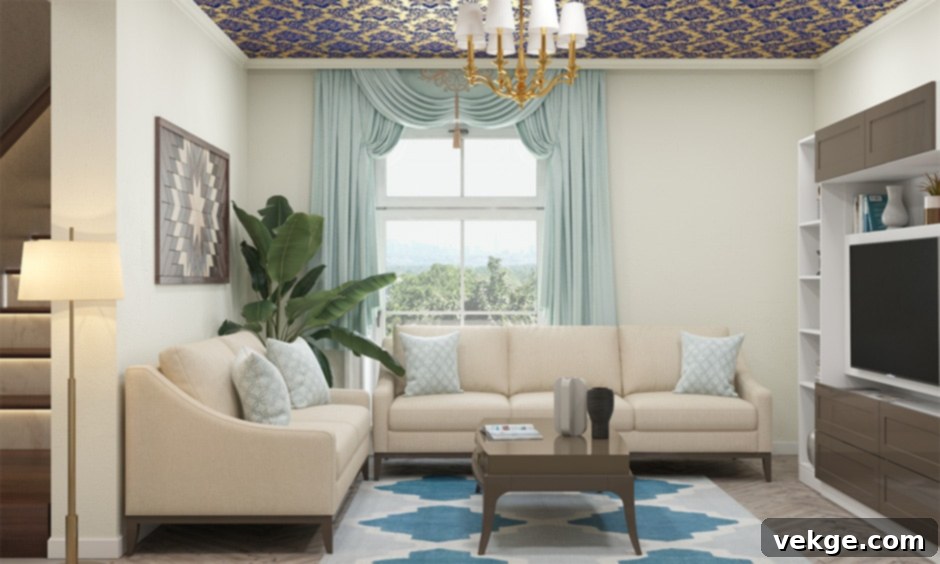Transform Your Home: Discover the Most Affordable & Attractive Ceiling Ideas
Many homeowners meticulously plan and maintain every corner of their living space, ensuring regular treatments and refurbishments for floors, walls, and furniture. However, one crucial element that often goes unnoticed in both new and old homes is the ceiling – frequently referred to as the ‘fifth wall’. This often-overlooked surface has immense potential to dramatically alter the aesthetic and feel of an entire room, yet it rarely receives the attention it deserves. While there are countless types of ceilings, very little thought is typically given to their beautification or how they can enhance a home’s overall design.
The good news is that elevating your ceiling doesn’t have to be an expensive endeavor. Creative and budget-friendly ceiling modification ideas, many of which can be tackled as DIY projects, can make a profound impact. A well-designed ceiling can make a room feel more welcoming, spacious, and stylish, completely transforming its ambiance. In this comprehensive guide, we will explore some of the most affordable, attractive, and durable ceiling types, offering practical solutions to strengthen your ceiling’s integrity and boost your home’s appeal without spending a fortune.
What is The Cheapest Ceiling Type? Debunking the Myth of a Single “Cheapest” Solution
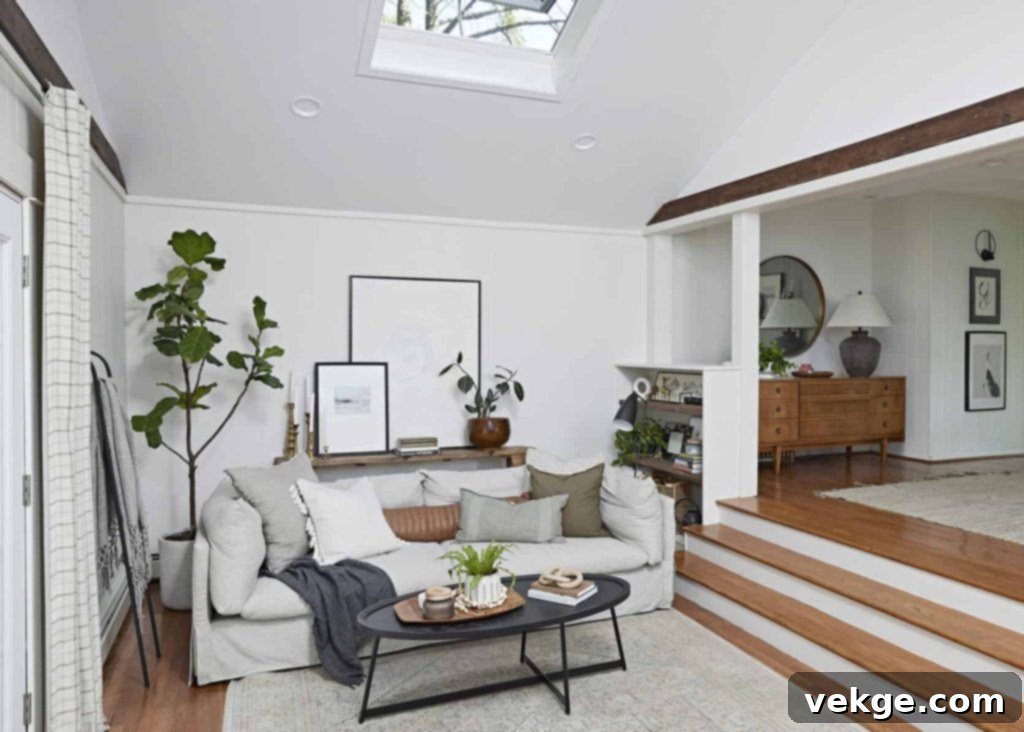
Before diving into specific recommendations, it’s essential to clarify a common misconception: there isn’t one single “cheapest” type of ceiling that applies universally. The total cost of a ceiling treatment is highly dependent on a variety of factors, making a direct comparison often misleading. These factors include:
- Material Costs: The price of raw materials can vary significantly. For instance, natural wood panels will cost more than PVC or MDF alternatives.
- Labor Charges: If you hire professionals, installation costs can be a major component of the overall budget. DIY projects, while requiring your time and effort, can drastically reduce labor expenses.
- Ceiling Repair & Preparation: Existing ceiling damage, uneven surfaces, or complex preparation work will add to the cost.
- Complexity of Design: Intricate patterns, custom finishes, or integrated lighting systems will naturally be more expensive than simple, straightforward designs.
- Geographic Location: Material and labor costs can fluctuate based on your region.
- Longevity and Maintenance: A slightly more expensive but durable and low-maintenance option might prove cheaper in the long run than a very cheap solution that requires frequent repairs or replacement.
Therefore, instead of searching for the absolute cheapest option, it’s more beneficial to focus on affordable ceiling ideas that offer excellent value, a long-lasting impact, and align with your home’s aesthetic. In this article, we present a curated list of budget-conscious ceiling treatment ideas that don’t compromise on visual appeal or durability.
1. Suspended (Drop) Ceilings: Practicality Meets Style
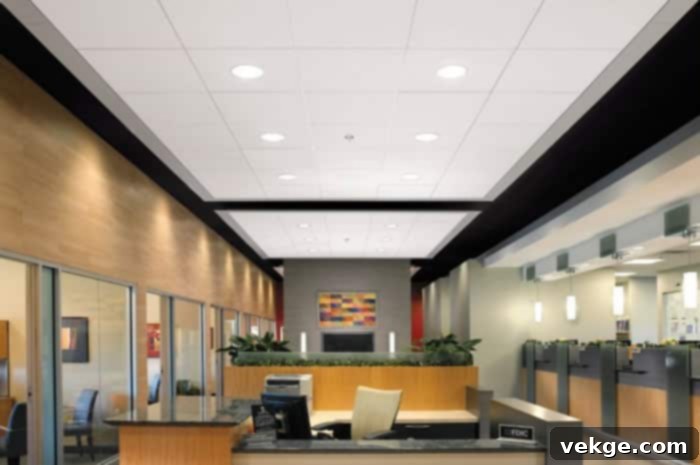
Also widely known as drop ceilings or T-bar ceilings, suspended ceilings are an incredibly practical and versatile solution. As the name suggests, these ceilings consist of tiles that are suspended from the main structural slab or roof overhead using a grid system of metal channels and wires. This creates a secondary, lower ceiling plane, offering a multitude of benefits for both new constructions and renovations.
One of the most significant advantages of a drop ceiling is its ability to effectively conceal various imperfections and essential infrastructure. This includes unsightly roof damage, tangled wiring, HVAC ductwork, plumbing pipes, or any other elements you’d prefer to keep out of sight. Beyond aesthetics, they provide easy access to these systems for future maintenance or repairs simply by lifting individual tiles – a feature unmatched by traditional drywall ceilings.
Functionally, suspended ceilings excel in noise insulation. Many ceiling tiles are designed with acoustic properties that absorb sound, significantly reducing echoes within a room and preventing sound transfer between floors. This makes them an ideal choice for basements, home offices, and multi-story homes. Furthermore, they can offer improved thermal insulation, helping to regulate indoor temperatures and potentially lowering energy bills.
Beyond their practical benefits, modern suspended ceiling tiles come in a wide array of materials and designs, including mineral fiber, PVC, metal, and even decorative wood-look options. This variety allows for considerable ornamental flexibility. You can choose from smooth, textured, or patterned tiles to match your interior design theme. Integrated lighting systems, such as recessed lights or modern LED panels, can be easily installed within the grid, adding a touch of luxury and functionality. While they might slightly reduce room height, their ability to transform a space while offering practical advantages makes them a highly attractive and affordable option.
2. Coffered Ceilings: Achieving Grandeur on a Budget
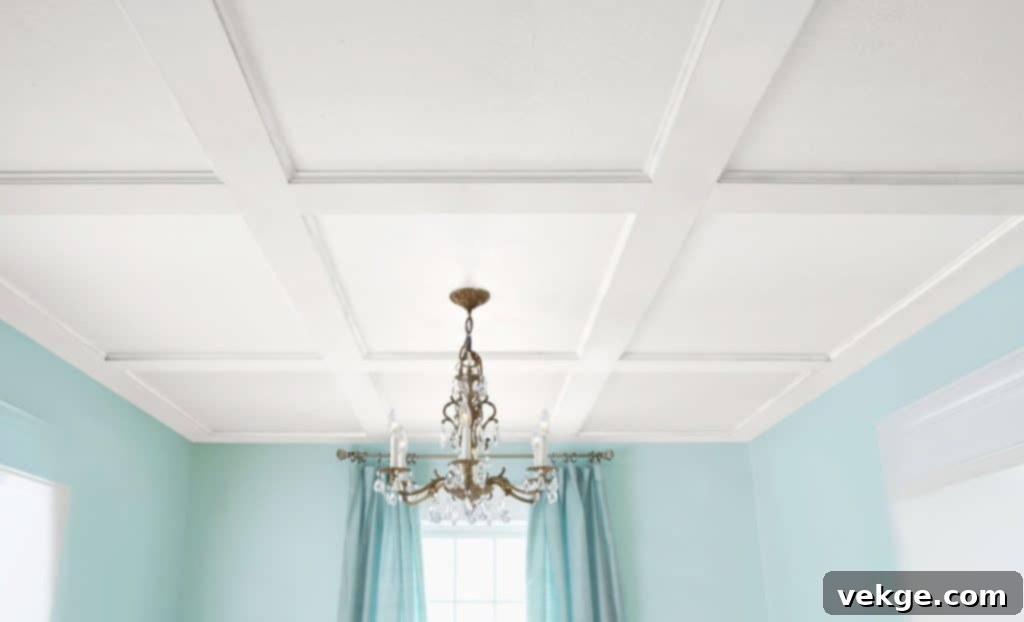
Coffered ceilings, with their distinctive sunken panels or recesses, evoke a sense of timeless elegance and architectural grandeur. Historically found in majestic castles and grand estates, these ceilings feature a grid of beam-like structures that create a series of recessed squares, rectangles, or other geometric shapes. While they may share a superficial resemblance to drop ceilings due to their grid pattern, coffered ceilings are typically integrated directly into the structural ceiling and do not involve suspension. Traditionally crafted from intricate wooden frames or plaster, genuine coffered ceilings can be quite an investment.
However, achieving this sophisticated look doesn’t require an aristocratic budget. Modern innovations allow homeowners to simulate the luxurious appeal of coffered ceilings at a fraction of the cost. This can be done using a variety of budget-friendly materials and DIY techniques:
- Faux Coffers with Molding: One popular method involves attaching pre-fabricated molding strips or simple wood trim to an existing flat ceiling to create the grid pattern. The “coffers” are then created by painting the recessed areas and the trim in contrasting or complementary colors, adding depth and dimension.
- Decorative Tiles or Wallpapers: Some homeowners use textured wallpaper or decorative ceiling tiles to line the “recessed” areas within a faux grid, adding visual interest.
- 3D Moldings and Panels: Lightweight polystyrene or PVC panels designed to mimic the look of wood or plaster coffers can be glued directly to the ceiling. These panels are easy to cut, install, and paint, making them an excellent DIY option.
- Pre-made Kits: Several manufacturers offer pre-made coffered ceiling kits that simplify the installation process, making it accessible for handy homeowners.
The challenging part is often getting the measurements and alignment of the indentations just right. However, with careful planning and execution, the visual difference between a genuinely expensive coffered ceiling and a well-executed makeshift one can be surprisingly minimal. If you’re a skilled DIY enthusiast, you can significantly reduce costs by recreating this classic architectural feature yourself, adding a rich, custom feel to your living room, dining area, or master bedroom.
3. Shiplap Ceilings: Rustic Charm and Timeless Appeal
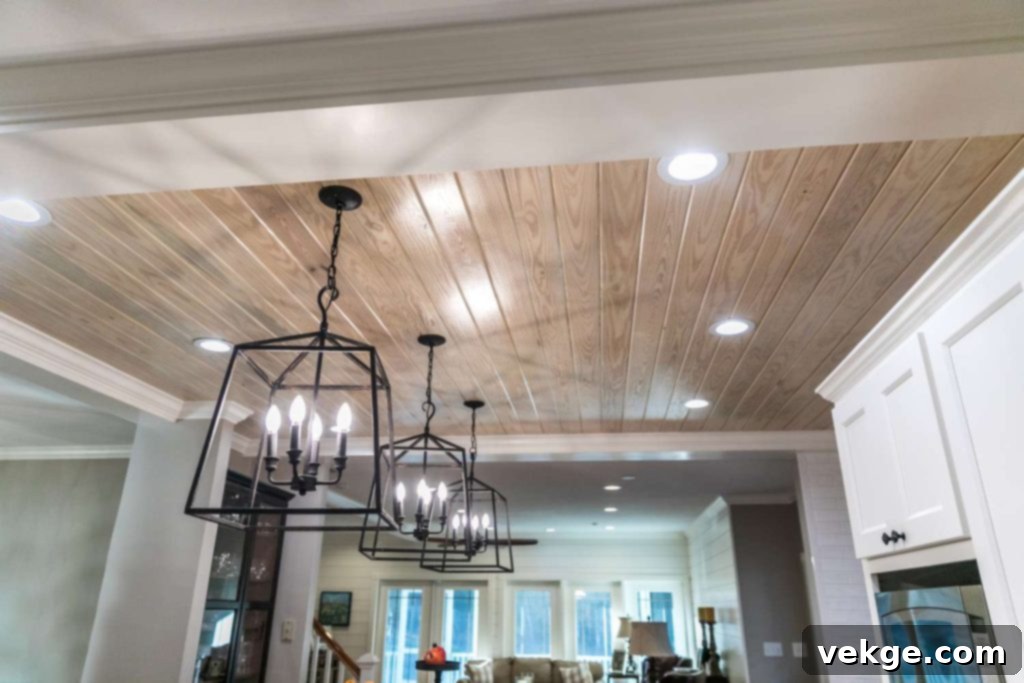
Shiplap has surged in popularity within interior design, transcending its traditional use to become a beloved accent for fireplace walls, bathrooms, and, notably, ceilings. For those unfamiliar, shiplap refers to wooden boards that feature a rabbet joint – a groove cut into the top and bottom edges of each board. When installed, these grooves allow the adjacent units to overlap, creating a distinct, tight, and slightly recessed joint that forms subtle shadow lines across the surface. This unique joint not only provides a visually appealing texture but also contributes to the material’s durability and weather-resistant properties, traditionally making it ideal for exterior siding.
When applied to ceilings, shiplap instantly injects a dose of rustic charm, coastal elegance, or modern farmhouse aesthetic, depending on the finish and context. While classic shiplap is typically made of solid wood (like pine or cedar), numerous budget-friendly alternatives are available for ceiling applications:
- Reclaimed Wood: Offers an eco-friendly and unique distressed look.
- MDF (Medium-Density Fiberboard): A more affordable and stable alternative to solid wood, easy to cut and paint.
- Plywood: Can be cut into strips and spaced to mimic the shiplap look, then painted.
- Vinyl or PVC Shiplap: Excellent for moisture-prone areas like bathrooms or porches, offering water resistance and easy maintenance.
The overlapping joint creates a snug fit, enhancing the ceiling’s resilience and longevity. This makes shiplap ceilings not only visually appealing but also a sturdy and protective covering for your home’s structure. Beyond its durability, shiplap adds a significant element of grandeur and sophistication, making it an excellent choice for prominent spaces like living rooms, master bedrooms, or outdoor porch ceilings. Its versatility allows it to be painted in any color, from crisp whites that brighten and expand a space to darker hues that create a cozy, intimate atmosphere, seamlessly integrating with any interior design scheme.
4. Aluminum Ceilings: Modern, Durable, and Unique

If you’re seeking a departure from conventional ceiling types and yearning for a fresh, innovative design idea, an aluminum ceiling might be the perfect solution. Beyond its striking modern aesthetic, aluminum offers a host of practical benefits that make it an exceptionally strong and durable ceiling treatment option. Its inherent rust-resistant properties are a significant advantage, ensuring the long-term integrity and appearance of your ceiling, especially in areas prone to moisture.
Aluminum ceilings naturally lend a rustic, industrial, or chic minimalist vibe to any space, making them a superb choice for those who appreciate understated elegance and clean lines in their home decor. They are lightweight, easy to install (often available in tile or panel systems that can be affixed directly or within a grid), and require minimal maintenance, typically just a wipe-down with a damp cloth.
Key advantages of aluminum ceilings include:
- Durability: Highly resistant to dents, scratches, and impact.
- Moisture Resistance: Naturally waterproof and rust-proof, making them ideal for kitchens, bathrooms, laundry rooms, and basements where humidity is a concern.
- Fire Resistance: Aluminum is a non-combustible material, adding a layer of safety to your home.
- Design Versatility: Available in a wide range of finishes, including brushed, mirrored, textured, and perforated. They can also be factory-coated or painted in virtually any color to perfectly coordinate with your existing decor. You can even find embossed or stamped aluminum tiles that mimic the look of classic tin ceilings for a vintage touch.
- Thermal Properties: Aluminum can reflect light and heat, potentially contributing to energy efficiency, especially in warmer climates.
By choosing an aluminum ceiling, you’re investing in a durable, stylish, and low-maintenance solution that offers a unique aesthetic edge, moving beyond the ordinary to create a truly distinctive living environment.
5. Paneled Ceilings: Versatility and Simple Elegance
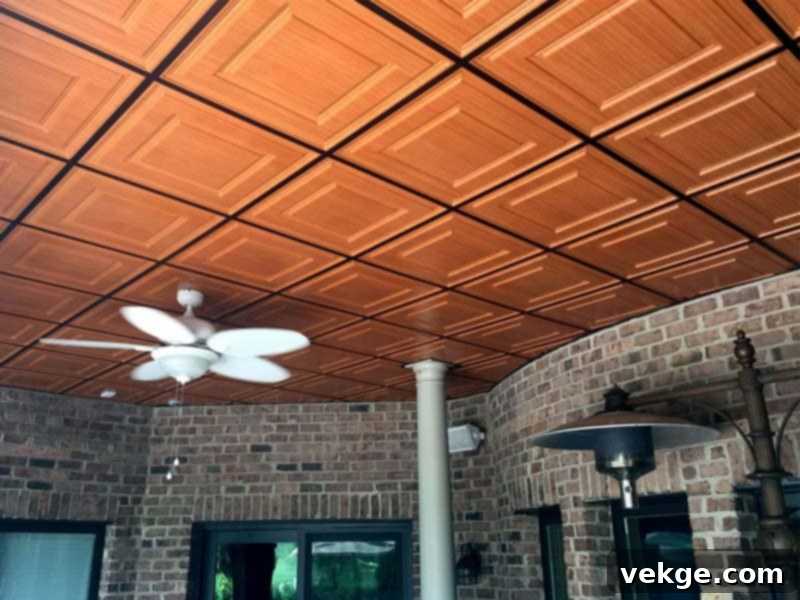
Paneled ceilings stand out as one of the most affordable, practical, and adaptable ceiling solutions available to homeowners. While they may not always be the first feature to grab attention, their understated beauty lies in their ability to provide a clean, refined backdrop that allows your room’s decor to take center stage. Simultaneously, they serve numerous utilitarian purposes, making them a smart choice for a wide range of applications.
These versatile panels are available in an impressive array of materials, each offering distinct advantages in terms of cost, appearance, and functionality:
- PVC Panels: Extremely lightweight, moisture-resistant, and easy to clean, making them ideal for bathrooms, kitchens, and basements. They come in various finishes, including smooth, high-gloss, and faux wood.
- Faux Wood Panels: Made from materials like MDF or composite, these panels provide the warm, natural look of wood without the higher cost or maintenance.
- 3D Textured Panels: Offer unique visual interest and depth, often made from PVC or plant fibers, and can be painted to match any decor.
- Medium-Density Fiberboard (MDF) Panels: An economical and smooth surface that’s excellent for painting. MDF is stable and uniform, offering a clean, modern look.
- Acoustic Panels: Designed to improve sound quality within a room, often used in home theaters or offices.
- Pressed Tin (or Faux Tin) Panels: Can add a vintage, ornate touch, often used in older homes or for a distinctive decorative effect.
One of the primary benefits of paneled ceilings is their ease of installation. Many systems are designed for quick and straightforward DIY application, often featuring interlocking edges or adhesive backing, significantly reducing labor costs. They are also excellent for covering up imperfections in an existing ceiling, such as cracks, stains, or uneven surfaces, providing a fresh, flawless finish.
To elevate the look of a paneled ceiling, consider adding a nice trim or crown molding around the perimeter, which can provide a polished, finished appearance. A decorative ceiling medallion can serve as a stunning centerpiece, especially when paired with a light fixture. Integrating recessed lighting or simple track lighting can highlight the panels’ texture or create a specific ambiance. With their contemporary appeal and wide range of customization options, paneled ceilings offer a simple yet impactful way to enhance your bedroom, living room, or any other space in your home.
Final Words: Unlocking the Potential of Your “Fifth Wall”
While it might seem that truly cheap ceiling types are limited, this perception is far from accurate. The world of interior decoration offers an expansive range of ceiling treatments, and with continuous technological advancements, along with the evolution of organic and high-end imitation products, truly remarkable and affordable ceiling solutions are more accessible than ever before. Modern manufacturing techniques have achieved finishes so remarkable that it’s often nearly impossible to differentiate between a costly, traditional ceiling and its budget-friendly counterpart.
This innovative landscape allows homeowners to assemble various types of ceilings at a significantly lower cost without compromising on style, durability, or quality. Furthermore, the increasing availability of DIY options for many of these ceiling solutions means that installation charges can be drastically minimized, leaving you primarily with the cost of materials. This empowers you to take control of your home improvement projects and achieve professional-looking results on a budget.
Don’t underestimate the transformative power of your ceiling. Beyond the structural and aesthetic benefits of the options discussed – from the practical versatility of suspended and paneled ceilings to the elegant charm of coffered and shiplap, and the modern edge of aluminum – you can further enhance their impact. Consider integrating elements like decorative wallpapers, vibrant paint colors, intricate murals, or thoughtfully placed lighting to create a truly unique and personalized space. By investing a little time and creativity into your ceiling, you can dramatically uplift the look and feel of your entire home, creating an environment that is both welcoming and stylish.
Do you have other budget-friendly ceiling ideas or DIY tips that have worked wonders in your home? We’d love to hear from you and share your insights in the comments section below!
